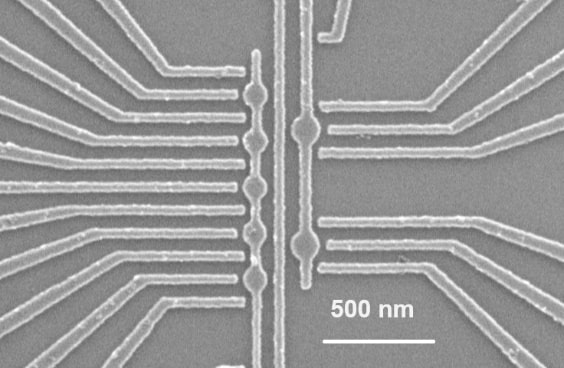Progress Report
Quantum Cyberspace with Networked Quantum Computer[3] Semiconductor networking technology
Progress until FY2024
1. Outline of the project
We will develop the technologies of quantum interface between photons and silicon qubits based on spin in semiconductor quantum dots (QD) and couplings between silicon qubits for constructing networks of semiconductor quantum computers. We also develop the connections of semiconductor qubits to large-scale optical networks. By accomplishing these subjects, we will contribute to the semiconductor networking technologies for fault-tolerant quantum computers as a Moonshot project goal.
Toward this goal, we develop quantum interfaces including the intermediate range couplings between silicon qubits, germanium hole qubits for photon-spin conversion, and entanglement generation between remote spin qubits pair from photon pairs (Fig. 1).

2. Outcome so far
① Multiplexed conveyer-belt spin shuttle
We have been working on the superconducting resonators coupled with spin qubits and the spin shuttle in a 1D array of QDs in collaboration with Fujita group in Tarucha project for the middle- and long-range couplings. The conveyor-belt spin shuttle, in which spin is transported by a moving potential driven by multiple sinusoidal signals with different phases, is becoming a promising method. We have proposed multiplexed conveyor-belt shuttle as a quantum connection between dense 2D spin qubit arrays. By the multiplexed conveyor-belt channels, qubits on one side of a 2D array are connected quantum mechanically to qubits on one side of the other 2D array (Fig. 2). We studied the design and fabrication of triple conveyor-belt channels.

② Superconducting resonator with a triple QD and cryogenic piezo stage-based light illumination system
As a photon-spin quantum interface, we study the superconducting resonators strongly coupled with spin qubits. To achieve a strong coupling, we employ enhanced Flopping mode in triple quantum dots, which was developed in our group. We have fabricated a NbTiN high-impedance superconducting resonator containing GaAs triple quantum dots for a proof-of-principle experiment (Fig. 3). For optical networking experiments, we have constructed a fiber optical delivery system that can precisely align photons transmitted by optical fiber to spin qubits using piezo-stages.

3. Future plans
We will investigate the scalability of the multiplexed conveyor-belt spin shuttle. The strong coupling between microwave photons and germanium spin qubits will be demonstrated. We will further investigate an optical-MW quantum interface, and entanglement conversion from photon pairs to spin pairs in two dilution refrigerators. We will develop fundamental technologies for a network-based quantum computer with spin qubits.